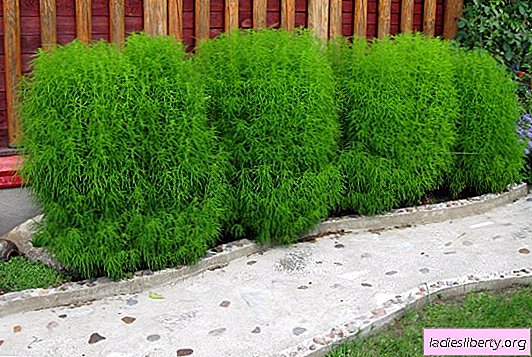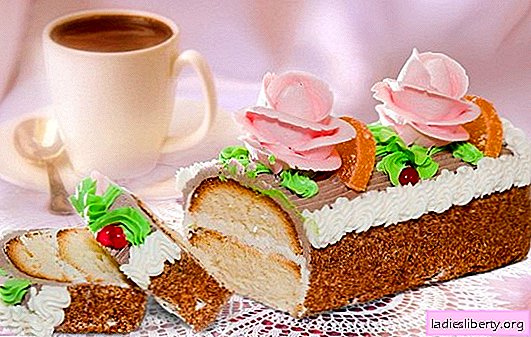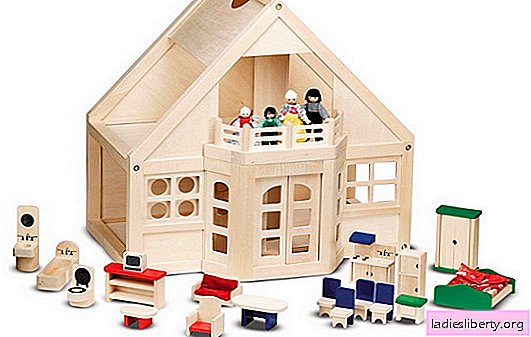
A rod, a broom, a ruff, a bassia - these are all the popular names of kohii.
This shrub from the Marev family, thanks to thin elongated leaves resembling needles and a highly branched structure, looks like a small Christmas tree.
Therefore, it is also called summer cypress. This plant has gained popularity due to its distinctive qualities:
• it is easy to trim (the shape of the bushes is limited only by the imagination of the "barber");
• has “chameleon abilities” (closer to autumn, the color of the leaves changes - depending on the variety, it can be purple, burgundy or remain emerald green until frost)

Variety of colors of kohiya
• drought tolerant and unpretentious (planting and caring for kohii are simple and do not require labor-intensive measures).
For these reasons, kohiya is often planted not only in summer cottages; landscape designers use it to create “living” labyrinths, borders and hedges. And as a tapeworm on a flower bed in combination with contrastly flowering plants, it looks great.
The main types of kohii
Summer cypress has about 80 species, of which about 10 are cultivated in horticulture, characterized by the most decorative and bush form:
• Hairy Bassia - an annual with a dense branched crown. The color of the leaves varies from a saturated light green hue in the summer to red or pink in the fall. It tolerates a haircut;
• Kohiya Childs - a compact shrub with a dense crown, reaching a height of up to 0.5 m. The color of the foliage (pale green) does not change with the onset of autumn;
• Bassia densely flowered - an annual tall species (reaches a height of up to 1.3 m). Its feature is that during flowering, long whitish hairs grow around the base of the flowers, giving the plant an unusual appearance;
• cochia sherstikotsvetkovaya - a low-growing variety of summer cypress (0.1-0.6 m) yellow-green. Twigs of the bush are densely covered with wavy villi;
• creeping cochia - a short perennial 0.1-0.5 m high with a powerful root system. Its branches covered with villi spread along the ground, for which the plant got its name.
Other varieties of perennial bassi have no decorative value; therefore, they are not cultivated in horticulture and are used mainly as feed raw materials.
Features of growing and planting kohii
Before planting summer cypress, you need to plan the place of its planting. Kokhiya is a photophilous plant and feels best in sunny areas (in nature it grows on rocky and semi-desert open areas).
With a lack of lighting, the color of the leaves will be faded, the branching will be weak, and the bush itself will lag behind in development.
Bassia grows well on drained, easily passing water and air to roots, soils with a slightly acidic or neutral reaction.
Lowlands and areas with a close occurrence of groundwater are not suitable for growing cohia. Its root system with moisture stagnation is susceptible to damage by various rot.
Ways of planting kohii (photo)
Green cypress is planted on flower beds with seedlings or seeds.
To obtain seedlings, cochia seeds are sown in the second half of March in plates with universal soil, to which perlite or coarse sand is added. Dishes for growing seedlings should be treated with an antiseptic, and the prepared soil should be shed with fungicide (for example, Fundazol, Topaz, Vitaros, Fundazol, Ridomil Gold, Previkur).
For successful germination of cochia seeds, it is important to follow these rules:
• the seed should be fresh (its germination is reduced within one year);
• availability of adequate lighting.
Seeds are laid out on moist soil to a depth of 1 cm. You can only lightly sprinkle them with a thin layer of sand or just barely press them into the soil with a spoon or a small piece of plywood.

Sowing kohii: seeds on the soil slightly press
After that, the landing boxes are covered with glass or a transparent film and placed on a warm windowsill. At room temperature, seedlings appear after 1-1.5 weeks. After that, they do not need shelter.
Young cochia seedlings are susceptible to such a disease as the "black leg", in which the lower part of the stem first turns brown, and then rots. Hence the name of the disease. Therefore, to reduce the percentage of damage to seedlings, boxes with it after emergence are kept in a cooler room at an air temperature of + 10-15 ° C. Seedlings are watered sparingly: with a lack of moisture, the plantlet quickly withers, with waterlogging, the possibility of a black-leg defeat increases. When the seedlings grow 2-3 real leaves, they are dived into separate pots.

Picking of seedlings of kohii
Although kohiya seedlings are not as whimsical as adult plants, unexpected spring frosts can ruin them. Therefore, it is better to plant it in the flower beds when steady warm weather is established + 18-20 ° C (last week of May - early June). Before planting, nitrogen-containing fertilizers (for example, ammonium nitrate or superphosphate) are introduced into the soil. After a month, top dressing is repeated.
Bassia can be sown directly into the ground. At the same time, the seeds are laid out in grooves at a distance of 30 cm from each other, so that in the future each plant has enough space for development. Immediately after sowing, the beds are watered and monitored so that the soil on them is always moist.
There is another tricky way to plant summer cypress: in the autumn, cut selected branches from the bush and put them on a bed in a greenhouse. In the spring under the dried-up “brooms” young shoots will appear. They can be peaked in separate pots or thinned, left in place, and when the seedlings grow older, transplanted into flower beds.
Kokhiya can breed self-seeding. If you leave a couple of adult bushes to winter, then in the spring shoots will appear. Thanks to the wind carrying seeds, kohiya can grow in any corner of the garden. Thick seedlings must be thinned out, otherwise the plants themselves will create a shadow for themselves and develop poorly.
The planting pattern depends on the desired result: for borders and hedges, plants are planted at a distance of 0.3-0.4 m from each other, and in flower arrangements the arrangement is arbitrary.
Cochia care (photo)
Summer cypress is an unpretentious culture. This "child of the semi-desert" is drought tolerant and is content with minimal care. However, in hot summer weather, kohiya still needs to be watered. It is better to do this in the morning and evening hours, otherwise leaf burns are inevitable.
Bassia is actively growing with regular feeding. In the spring, before planting, they make nitrogen fertilizers, and after a week they "treat" them again with the same drugs. A month later, foliar fertilizing with complex mineral fertilizers is carried out. To keep the leaf color bright, plants are watered every two weeks with liquid nutrient compounds (Kemira station wagon, Agricola, etc.).
Kokhiya loves aerated soils, so the earth around the bushes needs to be regularly loosened and weeds weed.
Another of the kohia care items is its pruning, which she can easily tolerate. Thanks to this bushes, you can give any configuration. After cutting, to maintain a weakened plant, it is fed with liquid mineral fertilizers.

Cochia Shaping Haircut
Summer cypress is resistant to diseases and pests. Of parasites, it is most often affected by a spider mite, which can be found by thin cobwebs between the branches and leaves of the plant. Acaricides (Apollo, Vertimek, Actellik, Sunmight) will help to destroy these insects.











